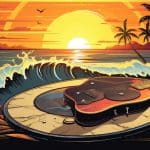
Surf music, characterized by its echoing guitar sound, emerged in the early 1960s and quickly became associated with the carefree beach lifestyle and youthful excitement. Its appeal lies in the catchy tunes and unique rhythmic style, making it an integral part of guitar playing. However, mastering surf music goes beyond merely imitating famous songs from that era. It requires a deep understanding of blending the right playing techniques with the perfect guitar sound. In the following section, we will delve into what makes surf music so special, exploring its origins and examining the intricate elements that have sustained its popularity. By doing so, we can gain insights into this guitar-centric genre and uncover the essence of capturing the true spirit of surf music.
Origins of Surf Music
Surf music came to life in the early 1960s, inspired by the surfers in Southern California. It’s known for its distinct guitar sound that echoes and rhythms that drive forward, much like the feeling of riding a wave. The music captures the excitement of surfing.
Dick Dale was a key figure in making surf music popular. He played his guitar very fast and used musical styles from the Middle East to create a unique sound. The Fender Stratocaster guitar, with its special echo effect, was the perfect tool for surf musicians. They often used two amplifiers at once to make the sound even richer.
The way they played the guitar, with quick picking and using the tremolo arm for effects, made listeners feel like they were at the beach. This music wasn’t just popular with surfers; it reached people everywhere.
Essential Surf Guitar Techniques
Surf guitarists create the sound of the sea in their music using special playing methods. They use a lot of reverb on their guitars to make it sound echoey, like the coast. This is because reverb can make the guitar sound like it’s in a big, open space, which is similar to how the ocean feels. They also play notes very quickly back and forth, which is called tremolo picking. This makes the music sound like the light that sparkles on the ocean waves.
They play two notes at the same time, called double-stops, and slide between notes, called glissandos, to make the music sound smooth and flowing, like water. To get the right sound, they use guitars with single-coil pickups, which make the guitar sound clear and sharp. By using these techniques, guitarists can make melodies that sound like they are surfing on top of the beat, doing so with accuracy and flair.
For example, if you want to try playing surf guitar, you might get a guitar with single-coil pickups, like a Fender Stratocaster or Telecaster. Then, practice playing with reverb and try quick picking to get the feel of the waves in your music. This will help you sound like classic surf guitarists and bring the vibe of the beach to your playing.
Iconic Surf Guitar Riffs
When you explore the world of famous surf guitar music, you’re bound to hear the distinctive sound of ‘Misirlou’ right away. That song, made famous by Dick Dale in 1962, captures the exciting spirit of surf music. It does this with fast picking on the guitar and a special scale that gives it an exotic feel, making it a tune you can’t help but remember.
Fans of surf guitar also love the sound of ‘Wipe Out’ by The Surfaris. The beginning of the song has a unique effect that sounds like ocean waves, thanks to a special guitar technique. These guitar pieces do more than just sound good; they represent what surfing culture is all about. They do this by making you feel the ocean’s wild force just by listening to the guitar playing.
Gear for the Perfect Tone
To get that classic surf rock sound, you need the right equipment. This includes old-school amps, reverb devices, and special electric guitars.
Fender guitars, like the Stratocaster and Jazzmaster, are perfect because they have single-coil pickups that give you a sharp and clear sound – that’s what makes surf music stand out.
Amps like the Fender Twin Reverb are also important. They have a great built-in reverb and can play loud and clear, which is a big part of that ocean-like sound in surf tunes.
Also, standalone reverb units, for example, the Fender Reverb Tank, are key for getting that genuine echo-y sound that feels like the ocean’s depth in surf music.
All these pieces of gear work together to make you feel like you’re right there on the beach with the waves.
Practicing Surf Songs Safely
When you’re getting ready to play surf music, having the right equipment is essential, but it’s just as important to be safe while you’re practicing. This means taking care of yourself and your gear.
One of the most important safety steps is to wear ear protection. Loud music can hurt your ears permanently, so it’s smart to use earplugs made for musicians. These earplugs lower the volume but still let you hear the music clearly. For example, you might want to use earplugs like the Vibes High Fidelity Concert Earplugs, which are great for musicians because they reduce noise levels evenly. This way, you can avoid hearing damage and still hear the nuances of your music.
It’s also crucial to make sure your practice area is safe and well-organized. Keep cables out of the way so you don’t trip, and make sure there’s enough space to move around without bumping into your gear.
And don’t forget to keep the room cool to stop your equipment from getting too hot. Remember to always unplug and carefully coil your cables after practice to prevent falls, and perhaps consider a fan or air conditioner for better airflow if your practice space gets warm.
Following these tips will help you keep playing your best without any accidents or damage. Chat with fellow musicians about their safety habits too—it’s a great way to pick up new tips!
Conclusion
Surf music is a unique type of music that started in the 1960s. It’s known for its lively guitar playing and echoes. If you want to play surf music well, you need to learn certain strumming patterns and famous tunes.
It’s also important to use the right gear, like guitars and amplifiers that can create that special surf sound. When practicing, it’s key to do it regularly and be mindful of protecting your hearing. This helps you get better while also making sure you can enjoy playing music for a long time. For example, using earplugs during loud practice sessions can save your hearing.
If you’re looking for a guitar that’s good for surf music, the Fender Stratocaster is a classic choice because of its bright, twangy sound.








